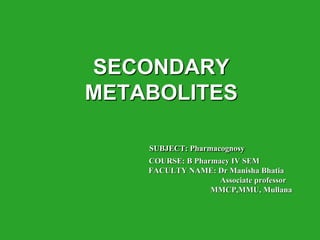
SECONDARY METABOLITE.ppt
- 1. SECONDARY METABOLITES SUBJECT: Pharmacognosy COURSE: B Pharmacy IV SEM FACULTY NAME: Dr Manisha Bhatia Associate professor MMCP,MMU, Mullana
- 2. • PRIMARY METABOLITES: Molecules that are essential for growth and development of an organism. Examples: • 1.Carbohydrates 2.Proteins 3.Lipids • 4.Nucleic acids 5.Hormones • SECONDARY METABOLITES: Molecules that are not essential for growth and development of an organism and are biosynthetically derived from primary metabolites. They are more limited in distribution being found usually in specific families.
- 3. • Secondary metabolites are those metabolites which are often produced in a phase of subsequent to growth, have no function in growth (although they may have survival function), are produced by certain restricted taxonomic groups of microorganisms, have unusual chemicals structures, and are often formed as mixtures of closely related members of a chemical family. • The simplest definition of secondary products is that they are not generally included in standard metabolic charts. • Plants produce a large, diverse array of organic compounds that appear to have no direct function in growth, development, photosynthesis, respiration, solute transport, translocation, protein synthesis, nutrient assimilation differentiation, or the formation of carbohydrates called as secondary metabolites.
- 4. • Thus small organic molecules produced by an organism that are not essential for their growth, development and reproduction are called secondary metabolites. • They may include pharmaceuticals, flavours, fragrance, food additives, feedstock etc. Possibly over 250,000 secondary metabolites in plants. • Classified based on common biosynthetic pathways where a chemical is derived. • Four major classes: Alkaloids, glycosides, phenolics, terpenoids
- 5. • Higher plants synthesize these wide variety of low molecular weight compounds called secondary metabolites in addition to the essential primary metabolites. • These offer protection against pests, they act as attractants and as the plant’s own hormones. Chemically meant to protect plants from the attacks by predators, pathogens, or competitors. • Attract pollinators as seed dispersal agent • Important for abiotic stress • Medicine • Industrial additives
- 6. • A metabolic intermediate or product, found as a differentiation product in restricted taxonomic groups, not essential to growth and the life of the producing organism, and biosynthesis from one or more general metabolites by a wider variety of pathways than is available in general metabolism. • They have a wide range of chemical structures and biological activities. They are derived by unique biosynthetic pathways from primary metabolites and intermediates. • These biochemical pathways are not necessary for growth or reproduction of an organism, but which can be demonstrated genetically, physiologically or biochemically.
- 7. • Plants produce an amazing diversity of low molecular weight compounds. • The ability to synthesize secondary metabolites has been selected through the course of evolution in different plant lineage when such compounds address specific needs. • Floral scent volatiles and pigments have evolved to attract insect pollinators and thus enhance fertilization. • To synthesize toxic chemical has evolved to ward off pathogens and herbivores or to suppress the growth of neighboring plants.
- 8. • Chemicals found in fruits prevent spoilage and act as signals (in the form of color, aroma, and flavor) of the presence of potential rewards (sugars, vitamins and flavor) for animals that eat the fruit and thereby help to disperse the seeds. • Other chemicals serve cellular functions that are unique to the particular plant in which they occur (e.g. resistance to salt or drought).
- 9. • Primary metabolism • The biological reactions are essential to maintain life in living organisms and are known as primary metabolism. • Plant convert sunlight energy to chemical energy, such as ATP, NADPH, by the mediation of chlorophyll in chloroplasts and synthesize sugars and starch from CO2 by using ATP and NADPH+. • These carbohydrates are stored and used for differentiation and formation of plant tissues.
- 10. • All organisms need to transform and interconvert a vast number of organic compounds to enable them to live, grow and reproduce. • All organisms need to provide themselves with energy in the form of ATP, and a supply of building blocks to construct their own tissues. • An integrated network of enzyme-mediated and carefully regulated chemical reactions in used for this purpose, collectively referred to as intermediary metabolism, and the pathways involved are termed metabolic pathway. • These processes demonstrate the fundamental unity of all living matter, and are collectively described as primary metabolism, with the compounds involved in pathways being termed primary metabolites.
- 11. • Secondary metabolism • The metabolism which are not directly related to maintaining life, are known as secondary metabolism. • The products formed by secondary metabolism are called secondary metabolites. • Secondary metabolite play a role in reinforcement of tissue and body (e.g. cellulose, lignin, suberin), protection against insects, diseases, and plant regulation (plant hormones).
- 12. • The compounds which synthesized from the secondary metabolisms are so-called secondary metabolites. • Secondary metabolites are formed in only specific organisms, or groups of organisms, and are expression of the individuality of species. • Secondary metabolites are not necessarily produced under all conditions, and in the vast majority of cases the function of these compounds and their benefit to the organism is not yet known. • It is this area of secondary metabolism that provides most of the pharmacologically active natural products.
- 13. • They are classified on the basis of: • 1) chemical structure • 2) chemical composition • 3) solubility in various solvents • 4) pathways by which they are synthesized
- 14. • A simple classification of secondary metabolites includes three main groups: • 1) the terpenes- made from mevalonic acid, composed almost entirely of carbon and hygrogen • 2) phenolics – made from simple sugars, containing benzene rings, hydrogen and oxygen • 3) nitrogen-containing compounds – extremely diverse, may also contain sulphur